In: Bart Gazzola
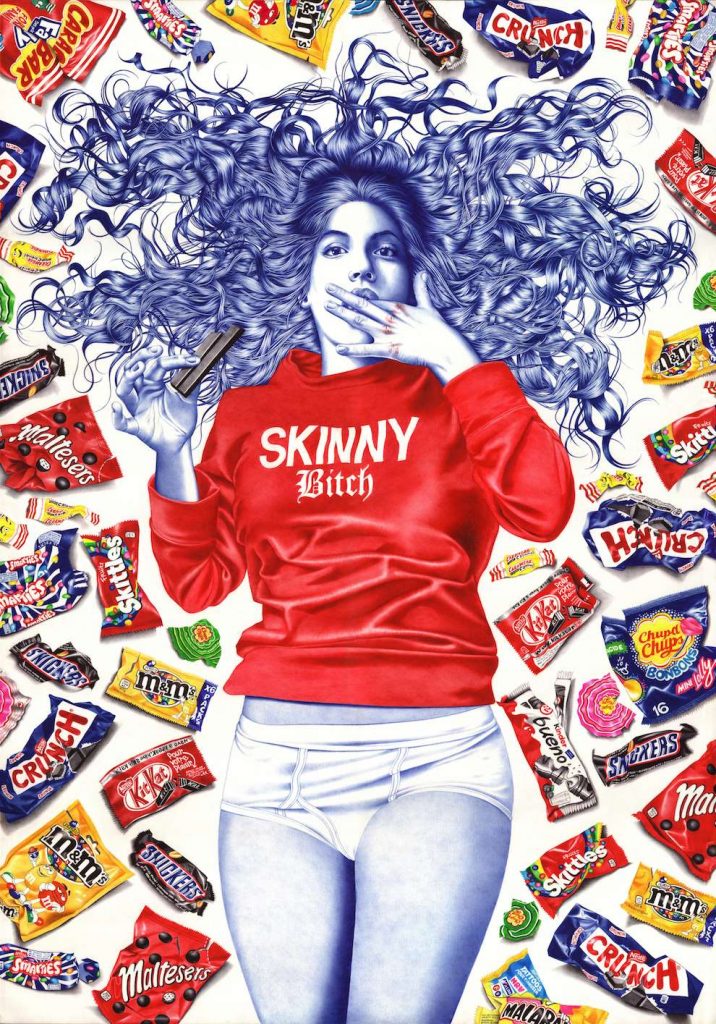
Mia | Helena Hauss, 2015
February 14, 2022Mia | Helena Hauss, 2015
One of my favourite scenes from the television series Sense8 is when one of the main characters is about to step into the ring, for an underground boxing match; a match between a male and female fighter – and the referee, in response to the man’s bravado, his arrogant assurance of his victory, is that “smart money’s on the skinny bitch.”
And the “smart money” turns out to be right.
Helena Hauss’ images are definitively feminist, but with a forceful humour that amuses and fractures a simplistic reading of her work. The aforementioned exchange came to mind due to the shirt worn by Hauss’ Mia, proudly proclaiming ‘skinny bitch’, as she reclines amidst tasty decadent snacks, not just unmindful of our judgement but meeting our gaze straight on, provocatively licking her fingers with eyes that make it clear she couldn’t give less of a fuck about what ‘we’ think.
Hauss works in ballpoint pen: her skill and discipline in this unusual format is awe inspiring, and there’s an audacity required in employing this medium that is matched by the vivacity and authenticity of the players in her tableaux. Whether in Mia’s unflinching stare, or the energy of The Fight or the impressive minutiae and detailed renderings of The Bet or The Sleepover, Helena Hauss is awesome in her medium.
Her words: My works all explore a same running theme of Irreverence : challenging an imposed decorum and reveling in one’s own pre-established labels rather than having to apologize for them.It’s about self-acceptance through self-deprecation and satire.
More of Helana Hauss’ work can be seen at her site, and her IG: @helenahauss.
She often shares videos of her process, which is lovely to enjoy as well.
~ Bart Gazzola
Read More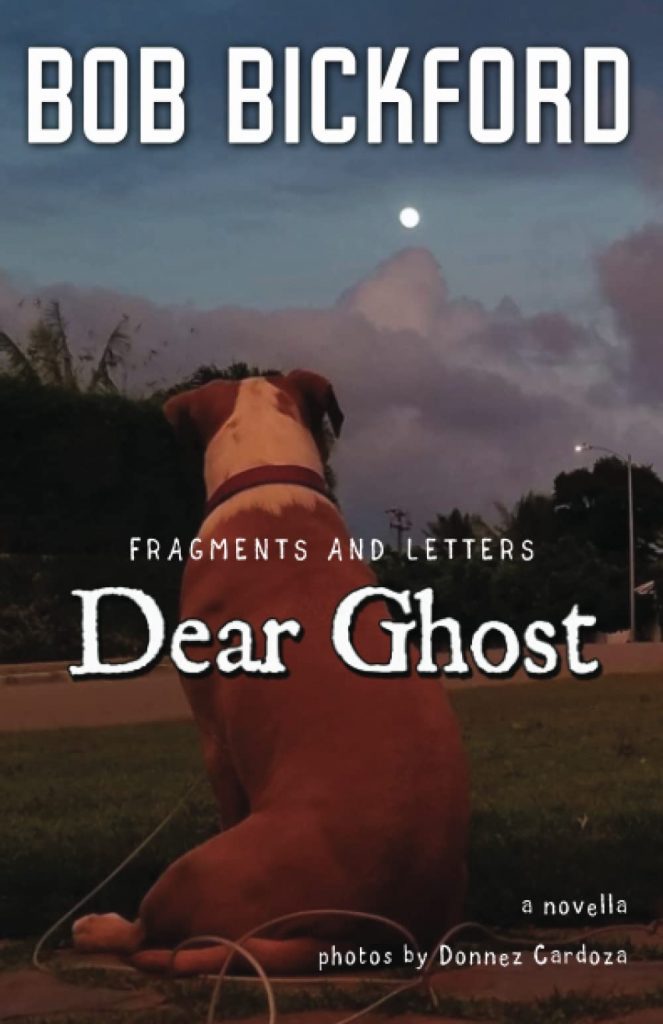
Bob Bickford | Dear Ghost, 2022
April 27, 2022Bob Bickford | Dear Ghost, 2022
https://www.bobbickfordauthor.com/books
M: When I was little and we used to move all the time, I’d write these notes and I would fold them up really small. And I would hide them.
C: What’d they say?
M: They’re just things I wanted to remember so that if I ever wanted to go back, there’d be a piece of me there waiting.1
Sometimes I wonder if phantoms wander the place, laughing and crying. Our memories, the echoes of us little, more vivid than we were in life. (Bob Bickford)
Bob Bickford’s novella Dear Ghost (subtitled Fragments and Letters) is a series of small gems of memory and mythology, filled with an honesty and erudite use of language that seduces you, with moments of sadness and joy that leave you wanting more. The chapters – or letters, more exactly – can be read in order, or out of sequence. They tell a story that is both intensely personal but also resonates with your own experiences. There is nostalgia, here, perhaps, but it’s not cloying or maudlin: “I am not sentimental about anything. But I have sentiment about many things. That’s an English-language difference that is very useful. Not to have sentiment is to be almost dead.”2
There are so many ‘fragments’ that I found myself noting, writing down for later use (as primarily an arts writer, I have often pilfered better writers than I to respond to visual arts), that seem to speak directly to you, and that in their simplicity cut right to your being.
Alluding to the autobiographical but not confined to it, Bickford’s letters are as much about feeling as ‘factual’ memory. His use of ‘ghost’ is about those things we know to be real, not requiring any substantiation beyond our own certainty. His final missive in the book asserts this: “Dear Ghost, They say no such thing as ghosts. I say it too, just to make you laugh… There are no endings, and everything that matters is invisible, or nearly so.”
Read the full review here.
Read More
dream listener | karen elaine spencer, 2006 – 2007
February 4, 2022dream listener | karen elaine spencer, 2006 – 2007
In a dream I saw a way to survive and was filled with joy. (Holzer)
I have dreamed a dream, but now that dream is gone from me. (The Matrix: Reloaded)
i wrote my dream on cardboard, went out into the street and held the cardboard dream in front of me. at the end of the day i abandoned the cardboard dream. over the year one hundred and ninety-four dreams were written on cardboard and shared this way. (karen elaine spencer)
There is a poetic brutality to karen spencer’s dream listener porteur de rêves works, and especially several that she’s shared online recently, looking backwards at this series. (The image I’m sharing here is from 2007)
These are stark images, both visually and in terms of what spencer has chosen to present. spencer and I became acquainted when she exhibited a postcard/billboard project (using an image taken from her first invitation with ATSA’s l’État d’urgence) in Saskatoon some time ago; we joked about how both of us liked to walk in the frigid temperatures of our respective cities, and how that gave us a different sense of the place and the people. spencer often seems to notice things that others ignore, in these images: sometimes those are discarded objects. Often they are detritus, or indicators, of discarded people. spencer’s work is very political, and often in the public sphere, as well.
“Her work questions the hierarchy inherent in use values and investigates how we, as transient beings, occupy the world we live in. The widely held belief in a linear movement forward, or “progress”, is confronted through her repetition of actions that lead nowhere. Rambling, dreaming, loitering and riding the metro are all activities spencer has previously undertaken as part of her practice. Actions are sustained over time (often a year or more) rendering her artistic practice indistinguishable from her daily life. She works with what is near at hand, materials that speak of our day-to-day existence: cardboard, oranges, bread, chalk. Through a détournement of materials or intentions spencer intervenes into spaces; hoping to shift, even if only ever so slightly, our perceptions of what is possible.” (from The New Gallery)
spencer’s words are plaintive yet engaging. There’s a sadness evoked that seems to speak to you, on a very personal level. Her other texts in this series are equally melancholic: I dreamed my insides were falling out astride a pile of domestic discards, i dreamt i wanted nothing more to do with death, i dreamt i was waiting but i don’t know what for and i dreamed i lay in a puddle and watched the rain fall on me (the latter two both on wood that we all recognize as that used to board up windows, an arbiter of damaged, empty – unwanted – spaces).
More of the dream listener interventions can be seen here. More contemporary works by spencer can be found on her IG feed: @karenelainespencer
~ Bart Gazzola
Read More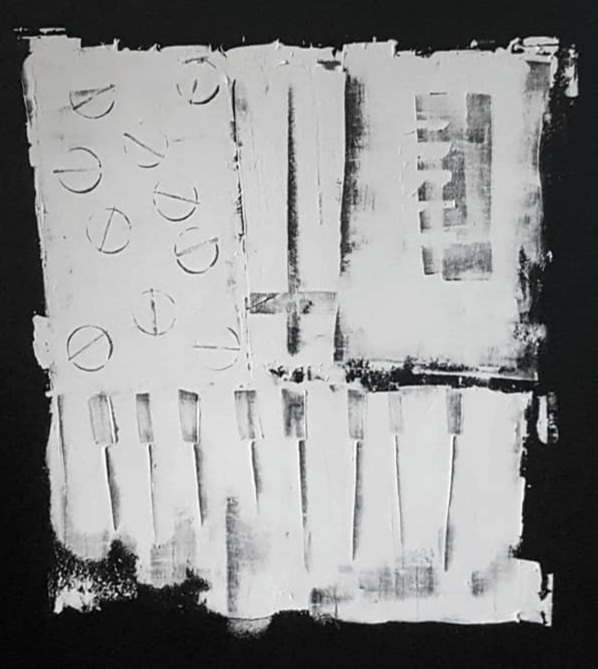
Chris Reilly – Balancing Act
February 4, 2022Chris Reilly Balancing Act Untitled by Chris Reilly Chris Reilly is an artist whose works are about seeking balance while also... Read More

Zhang Xiaogang | Girl and Tree, 2007 – 2008 – December, 2021
December 29, 2021Zhang Xiaogang | Girl and Tree, 2007 – 2008
Several years ago, a friend suggested Jan Wong’s book Red China Blues: My Long March From Mao to Now to me. It was a memoir that touched upon major historical events, but always with a personal stance of Wong’s experiences as both the child of Chinese immigrants to Canada, but also as a person who, as a teenager in the late 1960s, was enamoured of Mao Tse Tung, and lived for some time in China during the Cultural Revolution. Years later – as chronicled in the book – she would be in Beijing when the Tiannamen Square Massacre happened. It’s a good book: Wong is a meticulous narrator, and spares neither her young self, nor larger mythologies of the State (whether China or Canada) from an older, wiser voice of criticism.
When I first encountered the work of Zhang Xiaogang, Wong’s stories of the Cultural Revolution (which she was protected from, being a Canadian still too anaesthetized by ideology over reality) immediately came to mind. Zhang’s figures are grim: they also make me recall a ‘joke’ from another friend, whose family fled communist Poland, about ‘Soviet photo face.’ This is the idea – which any cursory review of official photography from the USSR, or any totalitarian state, really, will reveal – that you must offer a facial expression, in all images, that is neutral, lest it be used against you later, and you find yourself in the gulag or a re education camp.
“Inspired by contemporary tensions in China, Zhang Xiaogang makes grim, unsettling portraits that consider identity and heredity in a collectivist state. The artist draws on influences that include political iconography, Chinese charcoal drawings, distorted Surrealist compositions, and family portraits from the Cultural Revolution era. His paintings, often executed in grisaille with bursts of bright yellow or red at the center, explore how varied individual histories are flattened into conformist representations.” (from here, where you can enjoy more of Zhang Xiaogang’s artwork) ~ Bart Gazzola
Read More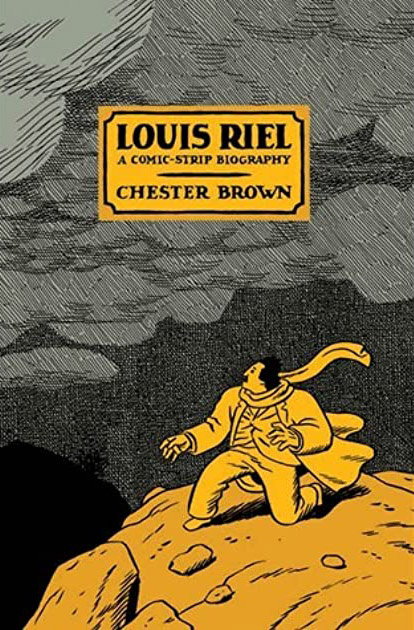
Louis Riel | Chester Brown, 1999 – 2003
February 23, 2022Louis Riel | Chester Brown, 1999 – 2003
Drawn & Quarterly, 2003
It seems an appropriate time to revisit Chester Brown’s excellent graphic novel Louis Riel (A Comic – Strip Biography), with Louis Riel Day having recently passed. I also say this not just due to recent domestic terrorism in Ottawa, but also as when I was living in Saskatoon, with a statue of Riel’s ally Gabriel Dumont prominently installed near the South Saskatchewan River, the reality of contested narratives about history was necessary to consider. An ongoing debate in Niagara, about a statue of a soldier glorifying the North-West Rebellion being removed from St. Catharines city hall, indicates this isn’t solely a regional concern.
More to this point: an exhibition at the now defunct Mendel Art Gallery a few years ago, on the work of James Henderson, displayed a full scale portrait of the judge who presided over Riel’s ‘trial’, where his execution was a foregone conclusion, and this fact was – still – not particularly welcomed when imparted to various tours and visitors.
“Chester Brown reinvents the comic-book medium to create the critically acclaimed historical biography Louis Riel, winning the Harvey Awards for best writing and best graphic novel for his compelling, meticulous, and dispassionate retelling of the charismatic, and perhaps insane, nineteenth-century Métis leader. Brown coolly documents with dramatic subtlety the violent rebellion on the Canadian prairie led by Riel, who some regard a martyr who died in the name of freedom, while others consider him a treacherous murderer.” (from here)
One of many fine publications from Drawn & Quarterly, this is one of a number of Brown’s excellent comics, and has been cited, along with Jeff Lemire (with his anthology Essex County) as an example of how ‘comics’ in Canada are engaging with historical narratives that are very relevant today.
Minimalist in format, this text fills in gaps that many of us were left with, studying history in school. Several years ago, in conversation with people from various parts of Canada, it was telling that Riel had been demonized in some historical accounts, completely ignored in others and given a more honest treatment in others. It’s an overused quote, but seems apt here : My people will sleep for one hundred years, but when they awake, it will be the artists who give them their spirit back. (Riel, as cited in The Defiant Imagination : Why Culture Matters (2004) by Max Wyman)
Louis Riel was the first comic book to receive a grant from the Canada Council for the Arts and has won three Harvey Awards.
A preview can be seen here and it can be purchased from Drawn & Quarterly, if you can’t find a copy at your local library. ~ Bart Gazzola
Read More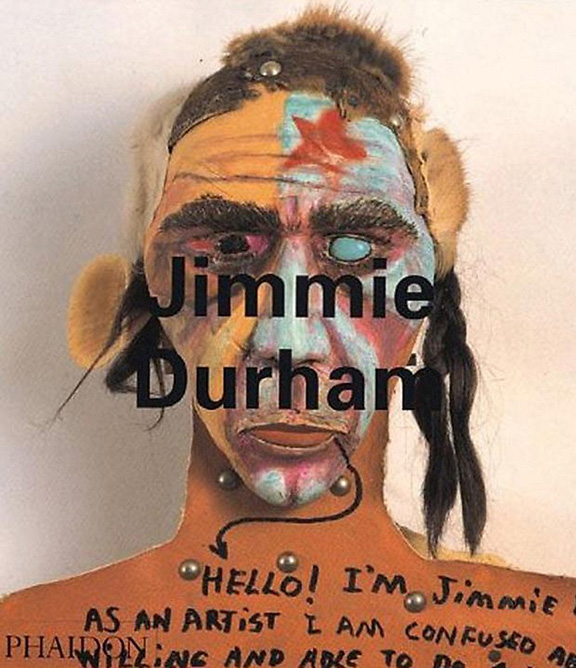
Jimmie Durham
January 21, 2022Jimmie Durham
Essays by Laura Mulvey, Dirk Snauwaert, Mark Alice Durant, Kate Nesin
240 illustrations
London: Phaidon, 1995
Jimmie Durham (1940 – 2021) passed away last year, and it’s an appropriate time to consider his legacy and his art. This book from Phaidon was originally published nearly two decades ago, and has been reissued recently, with some updates and further considerations about the artist, his work, and the controversy that suffused his practice, especially around his claims of Cherokee descent.
From Library Thing: “Jimmie Durham is an internationally acclaimed artist, writer and poet of [alleged] Cherokee descent. His intricate sculptures and installations mimic the attributes of human beings and animals, and the ways they make or are made into history. Durham collages discarded objects and fragments of organic matter, transforming them with dazzling colour into startling, anthropomorphic configurations. His ersatz ethnographic displays deliver ironic assaults on the colonizing procedures of Western culture. An activist in the American Indian movement during the 1970s, he has also published poetry, fiction and critical theory. Featured at Documenta 9 (1992), his work has also been exhibited at the Whitney Museum of American Art, New York, and the Institute of Contemporary Arts, London. The Survey by British film and art critic Laura Mulvey, author of ‘Visual Pleasure and Narrative Cinema’ and other influential essays, explores themes of history and language, space and time in Durham’s work. Belgian curator Dirk Snauwaert talks with the artist about his multi-faceted practice. In the Focus, Mark Alice Durant, US performance artist and writer, analyzes Durham’s diary of Shakespeare’s Caliban. For Artist’s Choice, Durham has selected texts by Italo Calvino about the loss of speech and the poetry of the invisible. Artist’s Writings include essays, poems and a screenplay published here for the first time.”
Durham is a very contested figure, and his artwork falls within that narrative, too. The exhibition Jimmie Durham: At the Center of the World came to the newly opened Remai Modern in Saskatoon, Saskatchewan, Canada, in 2018 – at the same time that his claims of Cherokee heritage were being hotly contested. As one of the first shows in that gallery, in a place that has often been referred to as the ‘Alabama’ of Canada for its systematic racism, it fired a number of arguments (not the least of which spilled back on some of the critics of Durham, who are associated with the University of Saskatchewan, perhaps as projection from their own issues with institutional racism and attempting to appropriate Indigenous identity to further exploit those communities). At the Center of the World could be seen as the spark that lit that situation, which is still burning….
I cite that to show how Durham’s aesthetic and ideas merit a re examination as they engage with experiences and histories that are being played out in numerous sites around Canada, if not the world, and this book (considering with Durham’s recent passing that readers might contemplate Durham’s life as a whole) allows for his life and legacy to be considered in a more ‘complete’ manner.
I’m familiar with the original edition of the book, but there is an updated edition, from Phaidon, which you can see more about here. ~ Bart Gazzola
Read More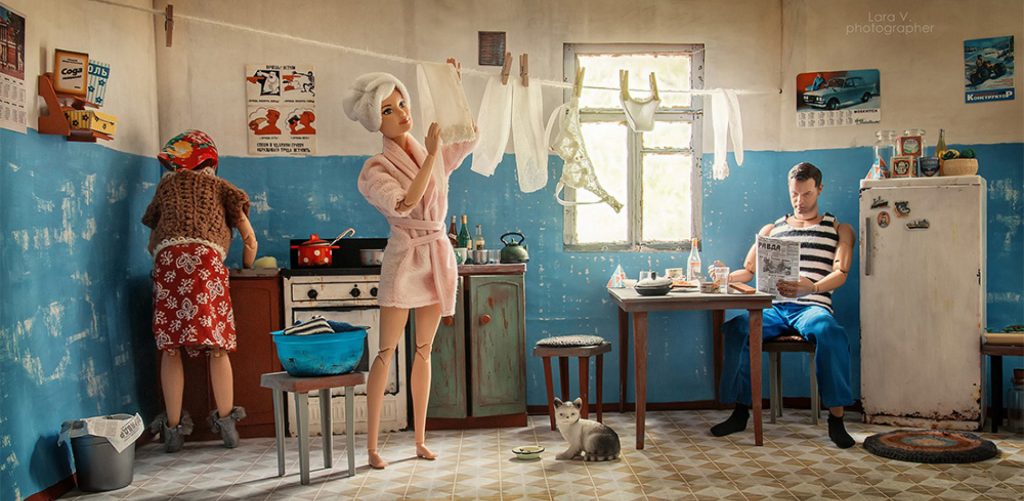
Lara Vychuzhanina | The life of Barbie and Ken in the Soviet Union
November 30, 2021Lara Vychuzhanina | The life of Barbie and Ken in the Soviet Union, 2017
First as tragedy, then as farce, we were warned a long time ago by Marx, is how history will play out. That’s a bit damning, but as we make our way further into the 21st century, it’s to be forgiven if many of us also see a more black than bleak humour in all this, a dark comedy that still makes us laugh, inappropriately.
Lara Vychuzhanina (whose Instagram name is aptly @lara_art_dolls) is a Russian photographer from Yekaterinburg – formerly known as Sverdlovsk, during the Soviet era, which I mention as it intersects with some of the ideas present in her work here, where she’s created a tableaux of Barbie and her partner Ken living in the USSR in the 1980s.
There’s always an element of nostalgia in depictions of history, allusions to a ‘simpler time’, and it’s interesting to see one about the USSR, as in the West we’re usually inundated with this false trope about the 1950s, or 1960s: Lara Vychuzhanina is too young to remember the 1980s in the former Soviet Union, but this doesn’t stop others from offering caustic and contested interpretations of those eras, either. Employing Barbie and Ken for this is a nice intersection of mythologies of East and West, capitalism and communism, plasticity and reality – and it is also, in the inherent contradictions of its assemblage, very funny.
After all, “comedy is in act superior to tragedy and humourous reasoning superior to grandiloquent reasoning” (which, fittingly, is attributed to Friedrich Engels by Karl Marx, back in 1862)…..
More images by this artist can be enjoyed at her Instagram. ~ Bart Gazzola
Read More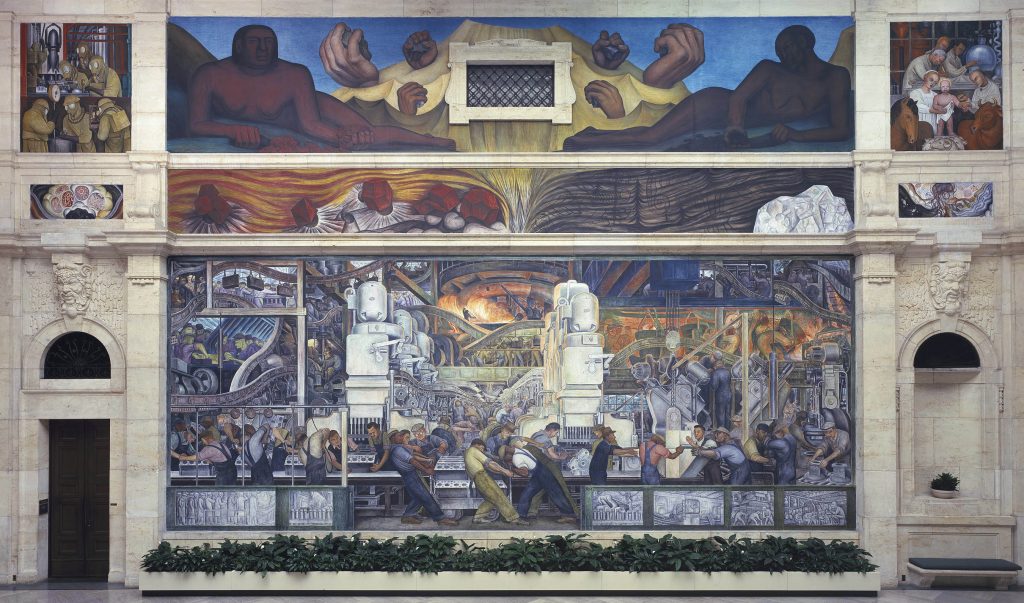
Diego Rivera | The Detroit Industry Murals
November 19, 2021Diego Rivera | The Detroit Industry Murals, 1932 – 1933
Diego Rivera’s work in the Detroit Institute of Arts, titled The Detroit Industry Murals, is one of the finest works of art of the 20th century, and easily one of the finest examples of a mural ever; it’s not inappropriate to appreciate it as the apex of the Mexican artist’s career, and it functions as a significant touchstone of not just the history of Detroit, but of North America and larger issues and ideologies that were dominant at the time of its creation but that still are prevalent now.
“Between 1932 and 1933, Diego Rivera completed this series of twenty-seven fresco panels entitled Detroit Industry on the walls of an inner court at the Detroit Institute of Arts. It was commissioned by capitalist Edsel Ford but conceived by the Marxist artist as a tribute to the city’s industries and labor force. Rivera used the Ford motor plant in Dearborn Michigan as the model for the industry murals. This plant, the Rouge Plant, spread all along the Rouge River, had a steel mill, glass factory, and auto assembly line. By the time Rivera visited these plants, the depression was in full swing but Rivera didn’t record accurately aspects of the Depression. Note, for example the predella panel where workers are lined up to receive their pay in front a parking lot filled with cars, a scene he would not have observed since the work force had been dramatically reduced. In addition to the automobile industry, Rivera chronicles the history and development of various other industries in the area.
At various times the murals have been controversial. Initially, some critics focussed on Rivera’s communism asserting that he had painted a communist manifesto. Others complained that the workers were depicted as dehumanized in the murals, even though most workers saw themselves as represented with dignity. Some complained that the nudes on the East wall were pornographic and saw the “Vaccination” panel as sacrilegious. Later, during the McCarthy era, a large sign was placed in the courtyard with the murals defending the artistic merit of the murals while attacking Rivera’s politics. More recently, a case has been made that the cycle is universal, reflecting “not only the essence of the industrial culture of Detroit but also a belief in technology and science that is operative today. As such, it is a history-making work of art in which the working class and industrialists both find affirmation.” And the aesthetic value of the series is no longer in doubt; many believe that this series of frescoes represent the best of Mexican mural art in the United States.”
This work also has to be seen as part of a larger series, including Rivera’s harsh Frozen Assets (1931 – 32) but also informing Self-Portrait on the Borderline between Mexico and the U.S. (1932) by Frida Kahlo, as they were a duo who contested and completed each other in their painting and ideologies. It’s also good to consider that too often, when engaging with art we privilege interpretations based upon ‘where’ we stand; this work – and the other ones I’ve mentioned by Rivera and Kahlo – looks at the United States with the eyes of an outsider (as I did, too, when I first visited it).
As a 19 year old new to the city of Detroit (and having my first real experience of the United States), The Detroit Industry Murals awed me (both in seeing the skyscrapers and trappings of the downtown that was the legacy of those glory days, and in stepping outside that bubble to the wasteland and abandoned industrial plants like detritus of a ‘better time’). To stand in the middle of the room, and be enclosed by these works, was a defining experience regarding both the possibilities and responsibilities of art. I’m offering a sampling of images here, but more can be enjoyed at this site: but truthfully, you must see this in person, in the downtown of Detroit, with all of its intersecting and contradicting narratives, and stand it its presence….
More images from this seminal work by Rivera can be seen here (and the long quote in this essay is also taken from there). ~ Bart Gazzola
Read More
Les Femmes Photographes De La nouvelle Vision En France 1920-1940 | Christian Bouqueret, 1998
January 13, 2022Les Femmes Photographes
De La nouvelle Vision En France 1920-1940 | Christian Bouqueret, 1998
Nicéphore Niépce Museum (Chalon-sur-Saône, Saône-et-Loire); Museum of Art, History and Archeology (Evreux); French Mission of photographic heritage; French association for the dissemination of photographic heritage.
This is the accompanying text to the exhibition Women photographers of the new vision in France, 1920-1940, which was on display in numerous places in France, including Paris (Hôtel de Sully, April 3-June 7, 1998), Chalon-sur-Saône (Musée Nicéphore Niépce, June 19-September 13, 1998) and Evreux, Musée of the old Bishop’s Palace, October-November 1998).
The artists in this show and the book are an impressive group of photographers whose works are still groundbreaking and evocative, almost a century later. These include Berenice Abbott, Laure Guillot, Denise Bellon, Ilse Bing, Germaine Krull, Dora Maar, Lee Miller, Claude Cahun, Lisette Model, Marianne Breslauer, Yvonne Chevalier, Nora Dumas, Gertrude Fehr, Gisèle Freund, Florence Henri, Annelise Kretschmer, Ergy Landau, Juliette Lasserre, Thérèse Le Prat, Dora Kallmus / Madame d’Ora, Rogi André, Ré Soupault, Gerda Taro and Camilla “Ylla” Koffler.
Bouqueret’s writing is in French, but the images are – of course – the real joy of this book. After reading it, I spent endless hours online, looking for more works by these artists. Research is too formal a word, as these photographs pulled me into a different time, and it was a way, again, in which the availability of artists’ works online is a treasure.
In light of that, I must also recommend this site: AWARE (Archive of Women Artists, Research and Exhibitions), as they have many images and information about the artists featured by Bouqueret, and much more.
It can be ordered online here, though I acquired a copy through my local library. ~ Bart Gazzola
Read More
Recent Comments